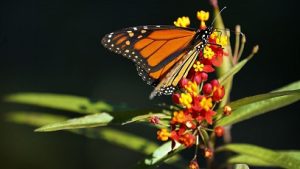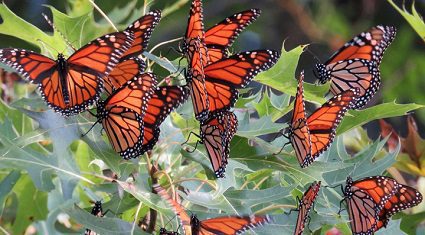Climate change affect butterfly species A groundbreaking study by researchers from the esteemed University of Cambridge and the Smithsonian Tropical Research Institute revealed butterflies’ adaptability to a warming climate. Smaller butterflies with lighter wings have trouble regulating their body temperatures as Earth’s temperature rises. Esme Ashe-Jepson, a dedicated Cambridge University doctoral student in zoology, discovered that color affects heat tolerance in these delicate creatures.
The investigation focused on Lycaenidae butterflies, revealing a new survival strategy. The findings show that smaller, paler butterflies struggle to adapt to rising air temperatures.
Size determines insect heat tolerance, according to research. The new study shows that color, previously overlooked, also affects butterflies’ temperature tolerance. This intriguing pattern appears to be butterfly-specific.
“Darker-winged butterflies, regardless of their wing size, had consistently better outcomes throughout the research,” said lead study author Ashe-Jepson.
Due to its implications for how butterfly species may fare under climate change, the July 12 Journal of Animal Ecology study has garnered scientific attention.
Butterflies regulate their body temperature using thermal buffering and thermal tolerance. Thermal buffering involves moving to cooler or shadier areas or angling their wings away from direct sunlight. It uses the butterfly’s size and ability to absorb heat with its wings. Larger-winged butterflies absorb and distribute heat better.
However, heat shock proteins protect the body from high temperatures in thermal tolerance. These proteins may hinder butterfly growth and reproduction.
The study confirmed earlier findings that butterflies use thermal buffering or thermal tolerance but not both. Certain species are more susceptible to climate change-induced temperature rises.
The University of Cambridge and the Smithsonian Tropical Research Institute conducted extensive fieldwork in Panama to study thermal buffering and thermal tolerance in tropical butterfly species. Between February 2020 and March 2022, scientists collected butterflies from diverse habitats in wet and dry seasons.
The fieldwork captured, tested, and released 1,334 butterflies from 54 species in six butterfly families. This laborious task required delicate handling and measurements to ensure accuracy.
“The goal was to catch a butterfly without chasing it,” said Ashe-Jepson. The team measured butterfly body temperatures accurately without stressing them.
A thermocouple measured the butterfly’s temperature for the thermal buffering test. The butterfly’s thoraxwhere its flight muscles and temperature regulation are most importantwas gently placed against the device.
The thermal tolerance test used fewer butterflies. To test its tolerance, each butterfly was kept in a glass jar and gradually heated to test its dehydration. Researchers measured how much heat butterflies could withstand before “knockdown,” where they lost motor control.
Results were astounding. Darker butterflies were better at warming and cooling. In the in-glass test, smaller, darker butterflies had higher thermal tolerance, while larger, darker butterflies were better at thermal buffering.


READ MORE: Dingo Selfies Fined: Wild Dingo Encounters Amidst Rising Attacks
Ashe-Jepson found that butterflies could survive temperatures up to 140 degrees Fahrenheit (60 degrees Celsius). “This is a massive difference for butterflies that live in relatively similar habitats,” she said, emphasizing the importance of these findings.
Larger butterflies with better thermal buffering showed unexpected vulnerability. These butterflies performed worse than smaller-winged ones. The study suggests that species with more stable body temperatures may struggle with temperature increases when they cannot adjust their position or find cooler surroundings.
Several factors explain how color affects butterfly heat tolerance. Because they absorb solar radiation better than pale butterflies, dark-winged butterflies can handle higher temperatures. They also radiate heat better, cooling their bodies. Thus, they rarely overheat.
Paler butterflies prefer cooler microclimates. However, the loss of forest habitat due to the climate crisis threatens these butterflies, especially during heatwaves. They could suffer serious consequences if they can’t control their body heat.
Climate change may affect butterfly species, but many are already endangered. The study shows which species can survive harsh climates.
If urgent action is not taken to preserve their habitats and combat climate change, the Lycaenidae butterfly family may rapidly extinction. Maintaining forests and microclimates can help save these stunning butterflies.
Extreme weather events are threatening these delicate creatures. With timely and concerted efforts, we can preserve these vital ecosystem members and their diversity for future generations.
Our Reader’s Queries
How are butterflies affected by climate change?
Monarch butterfly life cycle stages are affected by climate change in several ways. First, wetter conditions result in fewer eggs being laid by the butterflies. Then, warmer temperatures lead to reduced growth of milkweed, which leaves caterpillars without enough food. Additionally, erratic winters cause pupae to freeze, impacting their ability to survive. Lastly, the shifting seasons disrupt the natural migration patterns of the monarchs. These impacts highlight the vulnerability of these beautiful creatures to the changing climate.
Which type of butterfly is more vulnerable to changes in temperature?
The Lycaenidae family could suffer from the impacts of climate change, potentially leading to a significant loss of species in the tropical regions. The researchers emphasize that despite the focus on lighter, smaller butterflies being most vulnerable, the threat extends beyond just this group.
How does temperature affect a butterfly?
A slight inverse connection was observed between the temperature at which butterflies grow and their adult body size; for every degree increase in temperature, adult size decreased by around 1%. Warmer temperatures led to faster caterpillar development and increased growth rates, but ultimately resulted in a smaller adult body size.
What environmental factors affect butterflies?
The butterfly’s existence revolves around temperature. It dictates their appearance and capabilities, ultimately regulating their own internal heat.

